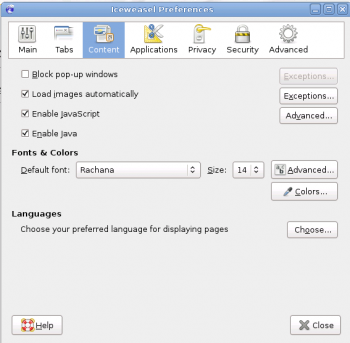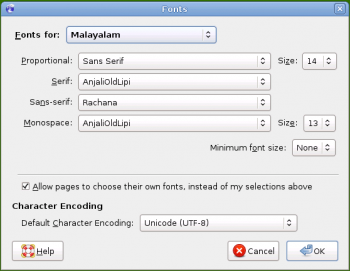"സഹായം:Reading Problems?" എന്ന താളിന്റെ പതിപ്പുകൾ തമ്മിലുള്ള വ്യത്യാസം
No edit summary |
|||
| (മറ്റൊരു ഉപയോക്താവ് ചെയ്ത ഇടയ്ക്കുള്ള ഒരു നാൾപ്പതിപ്പ് പ്രദർശിപ്പിക്കുന്നില്ല) | |||
| വരി 1: | വരി 1: | ||
On this page we will try to explain how to resolve problems when viewing the Malayalam pages. School Wiki uses [[:w:Unicode|Unicode]] to encode its pages. If you '''do not see Malayalam letters at all''' you may need a Malayalam Unicode Font, sections below explain the best options for various platforms. | On this page we will try to explain how to resolve problems when viewing the '''Malayalam pages''' on web browsers like firefox and google chrome. School Wiki uses [[:w:Unicode|Unicode]] to encode its pages. If you '''do not see Malayalam letters at all''' you may need a Malayalam Unicode Font, sections below explain the best options for various platforms. | ||
=== Malayalam Font setting in browser === | === Malayalam Font setting in browser === | ||
| വരി 91: | വരി 91: | ||
*[http://www.languagetype.com/malayalam/malayalam-fonts Language type] | *[http://www.languagetype.com/malayalam/malayalam-fonts Language type] | ||
*[https://malayalam.nd4.org/malayalam-fonts Malayalam Fonts] | *[https://malayalam.nd4.org/malayalam-fonts Malayalam Fonts] | ||
<!--visbot verified-chils-> | |||
02:17, 27 സെപ്റ്റംബർ 2017-നു നിലവിലുള്ള രൂപം
On this page we will try to explain how to resolve problems when viewing the Malayalam pages on web browsers like firefox and google chrome. School Wiki uses Unicode to encode its pages. If you do not see Malayalam letters at all you may need a Malayalam Unicode Font, sections below explain the best options for various platforms.
Malayalam Font setting in browser
If you see Malayalam letters but there are too many spelling mistakes your browser is probably not set up for Indic scripts.
There are 2 parts of the setup.
- Having a Unicode Capable Browser
- Having the Fonts


Browser
Since Unicode has gained popularity recently, If you use old browsers they might not have the capability to understand Unicode and hence they might display garbage. The developement in the Indic scene is so fast nowadays that its common to see drastic improvements between browser versions released just a couple of months apart. So you are better off getting the latest version of your web browser. The capabilities and version of your operating system might also come into play here.
IT@School GNU/Linux
- Mozilla/Firefox: Mozilla, Firefox and other Mozilla derived browsers have 2 options for font rendering. Their own renderer and pango. Pango is a better choice for redering Indic scripts but its disabled by default because pango makes the browser slightly slower. To compile Mozilla with pango enabled you have to configure with --enable-pango option.
- Konqueror: Konqueror is the native browser of KDE environment and I have heard that it has great support for international text. If Mozilla's support is frustrating you then you might want to checkout konqueror.
MS Windows
- If you are attempting to read Malayalam, Internet Explorer offers the most accurate rendering.
- Mozilla Firefox, although a highly recommended browser, does not yet offer great support for rendering Malayalam (The chillus are a problem). Firefox redering of Malayalam is currently a little buggy.
- I dont know whether the Indic fonts are installed by default or not, but similar to Mac OS X you should be able to run Windows setup CD/DVD and add the font package from there. The Devanagari font is called Mangal, the Telugu font is called Gautami, the Bengali font is called Vrinda, the Gujarati font is called Shruti, the Gurumukhi font is called Raavi, the Kannada font is called Tunga, and the Malayalam font is called Kartika (only available from XP-SP2 update).
- Install ThoolikaTraditionalUnicode Font, rajana font or AnjaliOldLipi.
For Debian/Ubuntu/IT@School
For ubuntu 8.10 and above or Debian lenny and above, there is no need of installing anything separately. All fonts are packaged with them and there is no rendering bugs.
For Older versions of GNU/Linux distributions follow the below steps :
Open the file /etc/apt/sources.list and add a new line deb http://download.savannah.nongnu.org/releases/smc/debian etch main. If you are using lenny or sid use lenny or sid instead of etch.
Open command line/ Terminal and use these commands.
# wget http://download.savannah.nongnu.org/releases/smc/praveen.key.asc # apt-key add praveen.key.asc # apt-get update # apt-get install suruma # apt-get install ttf-malayam-fonts
This will fix any rendering problem if there in your system. Then reload/restart your webbrowser/any other program you want to learn the fonts. Set font for the browser.
You can also perform a step by step graphical way using synaptic for correcting Malayalam. Screen shots are available here. More help about Ubuntu available here
For Microsoft Windows users:
Quick instruction for Windows XP + Internet Explorer users
Run AnjaliOldLipi Installer. No further steps required.
Details
If you have Windows XP with the SP2 update, you already have a working system. The Kartika font which comes with the SP2 update is a decent font. Please do not install the Thoolika font mentioned below.
The most likely reason why you cannot see anything on the School Wiki is that you do not have a font that supports the Malayalam Unicode range. If you can see some letters, but there are too many errors, you probably have a font with poor support for Malayalam Unicode. Perhaps the best fonts available are rachana by K.H.Hussain Anjali Oldlipi by kevin ThoolikaTraditional Unicode font. They work almost perfectly in Windows 95/98, ME, 2000, and XP (especially with Internet Explorer 5 or over). Please download the fonts by following the above links and install them. To install, copy the fonts, open "Fonts" from Control Panel and paste the fonts in the Fonts directory.
Internet Explorer users:
If you were able to see some letters, you will need to change the font Internet Explorer uses for showing Malayalam Unicode. To do this pull down Tools from the menubar in Internet Explorer and follow Internet Options..., click on Fonts (button). Choose Malayalam in Language script first, and choose a Unicode font (AnjaliOlpLipi, Thoolika, Rachana, Karthika etc) in the Web page font box. Restart Internet Explorer if it doesn't work the first time around.
Mozilla users:
It seems you need to turn on "Indic" support in Windows 2000. To do this, go to Control Panel in your computer, double click on Regional Options. In General Tab, language settings for the system, check the Indic box and click OK. You may need to restart the machine after doing this. In Windows XP, go to Control Panel in your computer, double click Regional and Language Options, select Languages Tab, under supplemental language support, check the box to install files for complex script and click OK. (Can somebody please confirm this?). In case you are still not able to see Malayalam letters properly in Mozilla, you should select the font Mozilla uses for Unicode by opening from Mozilla's menu bar Edit->Preferences->Appearance->Fonts. Choose "Fonts for:" as Unicode and all typefaces as Rachana_w01 or ThoolikaUnicode.
Firefox Users
AnjaliOldlipi works excellent on Firefox. To use it as default font to display Malayalam and Other Languages [from Tools menu > Options item > Content tab > Fonts & Colors section > Advanced button > Select "Malayalam" and set Anjali as font for serif/san-serif/monospace, do the same for Other Languages also.
Managing Chillu Charaters
Default Karthika font available in windows for Malayalam is not able to handle Atomic Chillu Characters defined in Unicode 5.1.0. But current version of popular AnjaliOldlipi supports atomic chillus. If you are reluctant to use fonts which are encoded with atomic chillus, and using Firefox, install this firefox extension to convert newly defined Chillaksharams to old fashion.
For users of GNU/Linux
Malayalam Fonts are available here. For installing fonts open your font folder (Open your file browser, type fonts:/// hit enter) and paste fonts in that folder. Restart any application that may need to use them. Your browser may need to set appropriate font (Font Rachana works fine, anyway check this page for finding appropriate font for you). Font setting for Firefox browser is available at Edit->Preference->Content->Advanced.
Sometimes you have to update your computer for better display of Malayalam. For that try tricks given below after login as a root. If these will not fix the problem please contact our Swathanthra Malayalam Computing or their irc chat paltform (this link will work in browser). A wiki related to "Malayalam computing" is available here
For Fedora
For Fedora 10 onwards, nothing to be done to enable Malayalam. All fonts are packaged and rendering issues are also solved.
For older versions follow these instructions : Download appropriate repo file for your computer ( Fedora 9, Fedora 8, Fedora 7, Fedora 6). Keep it in the folder /etc/yum.repos.d
Open command line/ Terminal and use the command
$yum update pango
After executing them set fonts for the browser then restart it. More help available here
Managing Chillu Characters
Even though new versions of Linux distributions are working fine with Malayalam; default fonts bundled with them are not supporting Atomic Chillu Characters defined in Unicode 5.1.0. This Modified version of Font Rachana renders newly defined atomic Chillaksharams. You can also use these fonts which has Atomic chillus. If you are reluctant to use fonts which are encoded with atomic chills, use this firefox extension to convert newly defined Chillaksharams to old fashion.
Downloading Malayalam Fonts
Malayalam Unicode font must be installed on the computer to view Malayalam letters without any problem. To download Malayalam Fonts go to the websites given below

